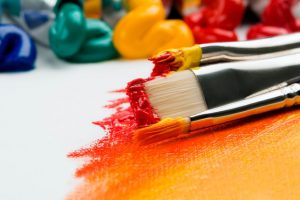Do you love to be creative? Do you enjoy taking part in art classes, while also enjoying your STEM courses? Art can help you build problem-solving skills in your STEM classes. So if you enjoy art and STEM, this is the article for you!
Newfound Sense of Creativity When Approaching Problems

Working on art projects, whether that be a painting or a sculpture, requires some creativity. This creativity can help lend a hand in the problem-solving department for STEM students. When students are asked to think creatively, they open their minds to new ideas and possibilities. By forming this skill through artwork, students will be able to apply this skill to other areas, such as in STEM.
STEM students are always needing to find solutions to problems and design new projects. If these STEM students possess the ability to think creatively, finding new creative solutions will become easier. Students will be able to think more creatively and apply this skill to the problems they encounter. Thus, STEM students will be able to cultivate more problem-solving skills, if they can be creative with their solutions through art.
Using Your Imagination to Solve More Problems
Art can encompass all different subjects; language arts, music, design thinking, and more. By incorporating more of these liberal arts into your STEM education, you are becoming a more well-rounded student. When writing essays for your language arts class or creating new musical pieces, your imagination is being used. When your imagination is being used, you are strengthening this skill. Using your imagination in your liberal arts classes can lead you to use your imagination more in your STEM courses. Having an imagination in STEM courses can advantage you significantly. Being an imaginative person will allow you to come up with more imaginative ideas and solutions to any STEM-related problem that you encounter.

Speak to the Experts
If that was not enough to convince you to incorporate more art into your studies, maybe learning about a few STEM “experts” will. Historically, lots of STEM pioneers have also been artists. Using their artistic skills, like having an imagination and being creative, allowed these scientists to be better problem solvers and scientists.
Have you heard of Leonardo da Vinci? Best known for his artistic skills, da Vinci was also a science revolutionary. Leonardo da Vinci posited that the Sun did not revolve around the Earth and sketched the inner workings of the human body. Without his artistic skills and abilities, da Vinci would not have been creative enough to solve certain scientific problems of the renaissance. His sketches are some of the first used to know the inner workings of the human body.
Another STEM contributor and artist is Santiago Ramon y Cajal. He used his artistic talents to solve problems related to neuroscience. Cajal drew detailed accounts of what he saw through his microscopes, and these depictions are the foundations of neurological studies. His artistic contributions helped solve neuroscience problems and aid in our understanding of how the brain works today. The artistic side of these scientists aided in their ability to solve the STEM problems of their age. This shows that art can be a useful tool to gain skills in creativity and imagination that can build into problem-solving skills in STEM courses.
By activating the artistic side of the brain, creativity, innovation, and imagination are the skills that are accessed. When these skills are developing through art, they can then be used in STEM courses to help solve problems and think creatively to design solutions. To learn more about STEM and the arts, please visit our site.
Written by: Meghan Latham
